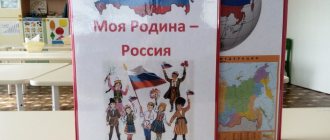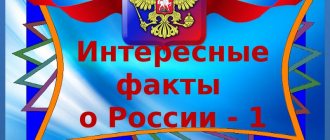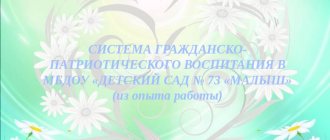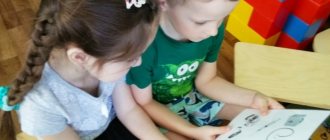Alina Sergeevna Ivashchenko
Card index of didactic games for patriotic education “My Motherland is Russia”
Didactic game in the life of a preschooler.
From an early age, children actively explore the world, exploring everything that happens around them. The main activity of children is play, therefore educational didactic games occupy the most important place in a child’s life. One of the main objectives of didactic games is the development of active and interesting play activities for children.
"My address…"
Goal: to develop the ability and knowledge of children to name their home address, city street, house number, apartment, telephone, floor, to consolidate knowledge of the right to housing, the inviolability of the home.
Material: ball.
Progress of the game: everyone stands in a circle, the teacher passes the ball to the child and says: “I live on ... floor,” the child continues, naming his floor, and passes the ball to his neighbor, etc.
"Our kindergarten"
.
Goal: to consolidate children’s knowledge about the kindergarten and about the kindergarten workers. What duties do they perform? Where is the group, music hall, etc. Strengthen the ability to navigate according to the plan in space.
Material: photographs and illustrations of the kindergarten, kindergarten workers. Plans for kindergarten, 1st, 2nd floors, groups.
Progress of the game: Using photographs and illustrations, children learn and talk about the kindergarten workers. According to the plan, children orient themselves in space.
"Search for Kind Words"
.
Goal: to use examples to reveal the meaning of the words “sorry, excuse me”
,
cultivate friendly relations , explain the need for an apology, admission of guilt or proof of rightness and justice, the connection between word and deed, word and attitude.
Progress of the game: The teacher begins a story about how to apologize, where and when, how these polite words are used.
“A journey along the route of good feelings, actions, deeds and relationships”
.
Goal: to draw children's attention to the fact that good feelings, actions and deeds evoke a feeling of respect, friendship and love. Form friendly relationships, establish rules of etiquette, rules of behavior.
Material: pictures with different scenes of good deeds, good and bad behavior.
Progress of the game: The teacher begins a story about how one should behave in a particular place, what actions are good.
"Our country"
.
Goal: To identify children’s knowledge about our Motherland , its capital.
Material: illustrations, photographs.
Progress of the game: the teacher shows illustrations and paintings , asks questions. The children answer.
"Small Motherland "
Goal: To reveal children’s knowledge about their Small Motherland , about the history of our city, monuments and attractions.
Material: illustrations, photographs of the city and our region.
Progress of the game: the teacher shows illustrations and paintings , asks questions. The children answer.
"Tell me about your family"
Goal: To form an image of yourself as a family member. Show the importance of family in a person’s life. Develop a desire to talk about your family members, be proud of them, love them.
Material: Photo album compiled together with parents with family photographs with a family tree.
“How do I help at home?”
Goal: To form ideas about the household responsibilities of women and men, girls and boys. Cultivate a desire to help people.
Material: Pictures depicting people doing different jobs around the house.
Progress of the game: The teacher shows the card , suggests making a story based on it and telling who performs what duties at home.
"Noble Deeds"
Goal: To cultivate in children the desire to do things for the sake of other people. To form an understanding that we call an action not only heroism, but also any good deed for the sake of another person.
Material: ball, pictures and illustrations depicting noble deeds.
Progress of the game: Children are asked to list noble deeds towards girls (women)
and boys
(men)
.
The teacher throws the ball into the hands of one of the players, he names a noble deed and throws the ball to the next player at his request.
“Who lives in which country?”
Goal: to expand children's knowledge about the world and the people who inhabit it. Material: paintings and illustrations of different countries of the world and peoples. Development of speech, logical thinking, formation of the ability to use the suffix - “ets”
.
Progress: The teacher shows images and asks to determine what country this person is from and what they will call him (Chinese-Chinese, African-African)
"Journey to Planet Earth"
Goal: To consolidate children’s knowledge that the Earth is a spherical planet (using a globe)
.
Show what movements the Earth makes (rotation around itself, around the Sun)
.
Help children find water on the globe (oceans, seas, rivers, land (mountains, plains, forests, deserts)
.
Foster in children an interest in studying the Earth on which we live - as a planet. Material: globe, world maps , pictures and illustrations depicting a planet.
“Find out who it is by the description”
Goal: to consolidate children's knowledge of the animal world of their native land. Instill love for the Native land, for the Motherland .
Material: Pictures and illustrations depicting the animal world.
Progress of the game: The teacher describes the animal , the children guess.
"Who has what house"
Goal: to consolidate children's knowledge of the animal world of their native land. Explain that animals also have the right to housing and the inviolability of their home. Material: pictures and illustrations depicting the home of animals.
Progress of the game: The bear has a den. The squirrel has a hollow.
“Which tree is the leaf from?”
Goal: to consolidate children’s knowledge about the nature of their native land, to consolidate the ability to form relative adjectives (birch - birch, oak - oak, etc.)
Material: Pictures and illustrations of trees, bushes and leaves.
Progress of the game: The teacher shows pictures depicting a leaf, then a tree.
"Green Pharmacy"
Goal: to consolidate children’s knowledge about medicinal plants of their native land; about their correct use for medicinal purposes.
Material: herbarium, card index of medicinal herbs .
Progress of the game: The teacher shows a picture of a medicinal herb, the children guess. The teacher talks about its healing properties.
"Little Red Book"
Goal: to consolidate children’s knowledge about rare plants, animals, birds of our region listed in the “Red Book”
.
Instill love for the homeland , native land, and a sense of responsibility.
Material: “small red book”
, compiled together with
parents , pictures and illustrations depicting rare plants, animals, birds. Progress of the game: The teacher shows a picture depicting rare animals and plants, the children name. The teacher talks about them .
"Countries and Peoples"
Goal: Expand children's understanding of the countries of the Earth and their peoples. To instill an interest in the lives of people with different lifestyles, cultures and traditions. Instill respect for the culture and traditions of different peoples of the world.
Material: globe, map of the World , dolls in national costumes, recordings of melodies of songs of different peoples, pictures and illustrations depicting different countries and peoples of the world.
Progress of the game: The teacher shows a picture depicting different countries and peoples of the world. Talks about them.
“What is the house built from?”
Goal: to improve knowledge of building materials, what a person’s home is made of, the ability to think logically, to consolidate the ability to form an adjective.
Material: Image of different human dwellings.
Progress of the game: Children look at pictures of houses. Word formations: glass - glass, stone - stone.
"Residential - Non-Residential"
Goal: to consolidate children’s knowledge that buildings are residential and non-residential.
People live in residential buildings; in non-residential areas there are organizations, utility rooms, etc.
Material: pictures and illustrations depicting different buildings.
Progress of the game: The teacher suggests identifying residential or non-residential premises: House - residential, store - non-residential...
"Call me kindly"
Goal: to improve children’s speech as a means of communication, to cultivate friendly relationships. Strengthen the ability to form diminutive words, introduce different names. Material: Progress of the game: Misha - Mishenka, Dasha - Dasha, Dashulya.
"I love…"
Goal: to cultivate a respectful , caring attitude towards loved ones, towards each other, develops communication skills.
Progress of the game: The presenter tells the children: “Each of us loves something or someone, all people have this feeling. I love my family, my job, I love you. Tell us who or what you love.” Children talk about their feelings and affections.
“How to find a path to kindergarten?”
Goal: To strengthen children’s ability to navigate the terrain plan, to be able to explain the location of objects in relation to each other. Strengthen the ability to determine the direction of movement. Develop abstract thinking. Material: area plan (neighborhood)
layout of the microdistrict area.
Progress of the game: children are guided by the plan and layout.
"Continue the proverb"
Goal: to introduce oral folk word-making, to develop speech, memory, and logical thinking.
Progress of the game: The teacher begins the proverb , the children continue it.
“Birds of our city (region)
»
Goal: to introduce children to the birds of their hometown (region)
.Instill love for
the homeland , native land, the animal world, the desire to help and care. Material: cards with images of birds, album “Birds of our city, region”
, compiled together with
parents .
Progress of the game: The teacher shows the children cards with images of birds, asks them to name and determine whether the bird lives in our city or not.
"Riches of the bowels of the earth"
.
Goal: to expand children’s understanding of the richness of the earth’s interior in minerals (coal, minerals, iron ore, precious stones)
. Expand children's understanding of the internal structure of the earth.
Material: collection of earth's fossils, pictures and illustrations of the earth's natural resources.
Progress of the game - The teacher shows the children a picture (natural fossil)
offers to name it.
"The World of Objects"
Goal: to generalize children’s understanding that in the world around us many objects are made by man from materials of natural or artificial origin (using various materials, a person studies and uses their properties)
.
Foster cognitive activity.
Strengthen the ability to form adjectives. Material: Pictures and images of household items.
MAGAZINE Preschooler.RF
Didactic game “Journey along Karl Marx Street in Beloretsk” Methodological guidelines for using the didactic game “Journey along Karl Marx Street in the city of Beloretsk” Purpose: To continue to acquaint students with their hometown and its streets. Introduce students to Karl Marx Street, to the buildings on this street, and to their purpose. To develop memory, attention, coherent speech, and logical thinking in students. Cultivate interest and love for your hometown. Equipment: playing field “Karl Marx Street”, 4 chips, cube.Preliminary work: Teacher's story, excursions and observations, looking at photographs of my hometown, reading popular science and fiction about my hometown, memorizing poems, composing children's stories, drawing the sights of the city, “the house where I live.” In older groups, selection local history material related to the history of his native city. Game rules: During the game, participants take turns making moves. A move includes several actions. The procedure cannot be changed. 1. Start the game from the start - “Kindergarten”. 2. Take as many “steps” as there are dots on the die. 3. If the chip is on the orange circle, then the turn goes to the other player. If on the brown circle, then return in the direction of the arrow. If the chip is on the green circle, move forward in the direction of the arrow. Turn order: The turn order is determined by the die; whoever has the highest roll goes first. You can use a counting rhyme. For example, the Bashkir folk rhyme: To play fun, you need to count everyone. One, two, three - you're first! “The one with whom the counting ends goes first. Progress of the game: 1st option 2-4 children participate in the game. Everyone puts their chip on the start. Take turns throwing the dice and moving the chips as many circles as there are dots on the dice. The player whose chip reaches the finish line first wins the game. Option 2 The game involves 4 children and a leader. According to the description of the presenter, players find an object and place their chips on the desired object. The winner is the player who is the first to correctly find all the objects described by the presenter. Option 3 With pupils of younger groups, the game can be used to familiarize themselves with individual objects of the city. The presenter puts the chip in order and talks about each object. When playing again, students can talk about objects. Option 4 The game involves two boys and two girls. Girls move their chips from the start to the left, and boys move to the right. The team that reaches the finish line first wins.
| Next > |
Progress of the game: cast iron - cast iron, wood - wood...
“On land, in the sky, on water, under water (transport)
»
Goal: Improving the grammatical structure of speech, consolidating prepositions in speech.
Material; a table showing the sky, sea, pictures : train, plane, steamship, truck, car, bus.
Progress of the game: The teacher asks the children to name small pictures , and then find a place for each of them in the big picture and make a sentence.
“On land, in the sky, on water, under water (animal world)
»
Goal: Improving the grammatical structure of speech, consolidating prepositions in speech.
Material; a table showing the sky, sea, pictures : animal world.
Progress of the game: The teacher asks the children to name small pictures , and then find a place for each of them in the big picture and make a sentence.
“Who needs what for work?”
Goal: To develop the ability to use the accusative and dative cases of nouns. Develop speech, logical thinking and memory. Strengthen knowledge about people's professions.
Card material depicting people of different professions.
Progress of the game: Children talk about professions, identify the items necessary for their work. (To the cook - ladle)
.
“Guessing and interpreting riddles”
.
(about the army, soldiers, Motherland , flora and fauna)
Goal: to introduce oral folk art, to promote children’s self-expression, the ability to make and guess riddles on a moral and patriotic theme .
Material: riddles and pictures with answers .
Progress of the game: the teacher makes a riddle , the children guess the riddle.
"Tell me which one"
Goal: to develop logical thinking, memory, speech, to develop skills in selecting definitions for words.
Material: cards with the image of the Motherland , flag, coat of arms, etc.
Progress of the game: The teacher shows the card and asks them to name what is depicted on it and select definitions for the image. ( Motherland is huge , powerful, beautiful, endless)
etc.
"Make a Family"
Goal: to develop logical thinking, memory, speech, to develop skills in selecting words of the same root and related words.
Material: cards with the image of the Motherland , flag, coat of arms, etc.
Progress of the game: The teacher shows a card and asks to name what is drawn on it and select related words with the same root: homeland , dear, parents , relative, mole ; hero - heroic, heroic, heroism; protection - protector, protect.
"Guess the profession"
Goal: To consolidate children's knowledge about professions. To develop the ability to divide professions into male and female.
Material: cards with images of people of different professions.
Progress of the game: An adult lists the actions of a person in a certain profession, and the children guess what kind of profession it is.
"I have a right."
Target. Expand the scope of children's legal knowledge.
Material: A set of narrative pictures for the articles of the “UN Convention on the Rights of the Child”
.
Pictures depicting situations not covered in the “Convention”
(a child riding a bicycle, playing hide and seek, watering flowers, etc.).
Progress of the game: Children take turns choosing a picture and explaining the reason for their choice, the rest discuss the correctness of the decision made.
"Who's doing what?"
Goal: to develop the skill of selecting verbs to nouns. Develop speech, logical thinking, memory.
Material: cards with images of people of different professions.
My hometown
Didactic board and printed game for children of senior preschool age
Goal
: work to develop patriotic feelings in children, familiarize themselves with the history and sights of their native land, taking into account the requirements of the Federal State Educational Standard for the regional component.
Tasks
:
- form an idea of the history of your city;
- develop children's cognitive interest in the history of their homeland;
- teach the rules of social behavior;
- develop the ability to work in a team;
- develop the emotional sphere of the child’s personality;
- train fine motor skills of the hands;
- train memory, thinking, attention, imagination;
- consolidate children's knowledge about the history of their city of Tsaritsyn-Stalingrad-Volgograd;
- expand your vocabulary, activate your vocabulary.
The game task of the didactic game “My hometown!” is to provide opportunities for children to demonstrate responsibility, independence, and cooperation. The teacher monitors and evaluates the results.
My hometown
Composition of the game: - field-map
This is a playing field-card with pockets on which there are images of the city of Volgograd at different times (when it was called Tsaritsyn, Stalingrad.
- cards
Each card contains three small pictures with views of the central places of the city and attractions in different historical periods time (Note: the places depicted on the map field must match the contents of the cards; the same places at different historical times.)
- chips
Each chip is a round medallion icon with the emblem of the city.
Guidelines for the game
Preliminary work with children must be carried out. It is necessary to talk about the history of the city, about different time stages in its development, about significant events. It is also useful to study the map, mark the city center and main attractions on it. Show how the appearance of the city has changed over time, what the same iconic places for the city look like in different years.
All photographic materials that will form the basis of the printed board game must be studied in advance with the children. After all the materials have been studied, you can begin gaming activities. The game should begin under the guidance of an adult; later, as children master it, they can play independently.
All materials for the game should be located in relation to the players so that they are clearly visible and convenient to use, so it is better to play the game at the table.
Progress of the game
Number of players: subgroup of children from 2 to 8 people.
Children sit down so that everyone can clearly see and conveniently reach and choose a card. The teacher gives each player his own playing field-card with an image of Volgograd at a specific historical time. Children carefully study the picture. Then, independently or with the help of a teacher, they choose a card that depicts the same place in modern times, insert the card into the pocket, comparing one of the three pictures with the card field, and explain their choice.
For a correctly completed task, a participant in the didactic game “My Hometown!” gets a chip. And then he can take another card field for himself. The game ends when all the children have completed the task and there are no free card fields left. The one with the most chips wins. The game can be played several times. When all the children begin to cope with the task easily, the game can be complicated. Invite children (one player or group) to compose a story based on the image.
While using the game “My Hometown!” Children's activities can be organized independently or collectively, with a subgroup of children. Didactic material can be used directly in gaming activities or offered during educational activities (on the topics: development of cognitive and research activities, familiarization with the phenomena of social life). The game helps stimulate children's cognitive interest in the history of their homeland, forms cognitive culture and patriotic consciousness. The didactic material of the game is appropriate for the age of the children and is practical to use when working with children.
Elena Astakhova, teacher of preschool educational institution No. 263, Volgograd
Progress of the game: Cook - cooks, fries, etc.
"Who are we? What are we like?
Goal: To consolidate children’s knowledge about man, to familiarize them with the external structure of the body and its capabilities, to develop the ability to compare and establish simple cause-and-effect relationships, to arouse interest in self-knowledge, to cultivate a caring attitude towards themselves and the world around them. Material: paintings and images of people (men and women.
Progress of the game: the teacher shows pictures with images and invites the children to find similarities and differences.
"Magic Words"
Goal: to evoke a desire to follow what is worthy of imitation, to objectively evaluate behavior, to cultivate a friendly and tolerant attitude towards people, the ability to compare and establish simple cause-and-effect relationships.
Material: paintings and images of people .



